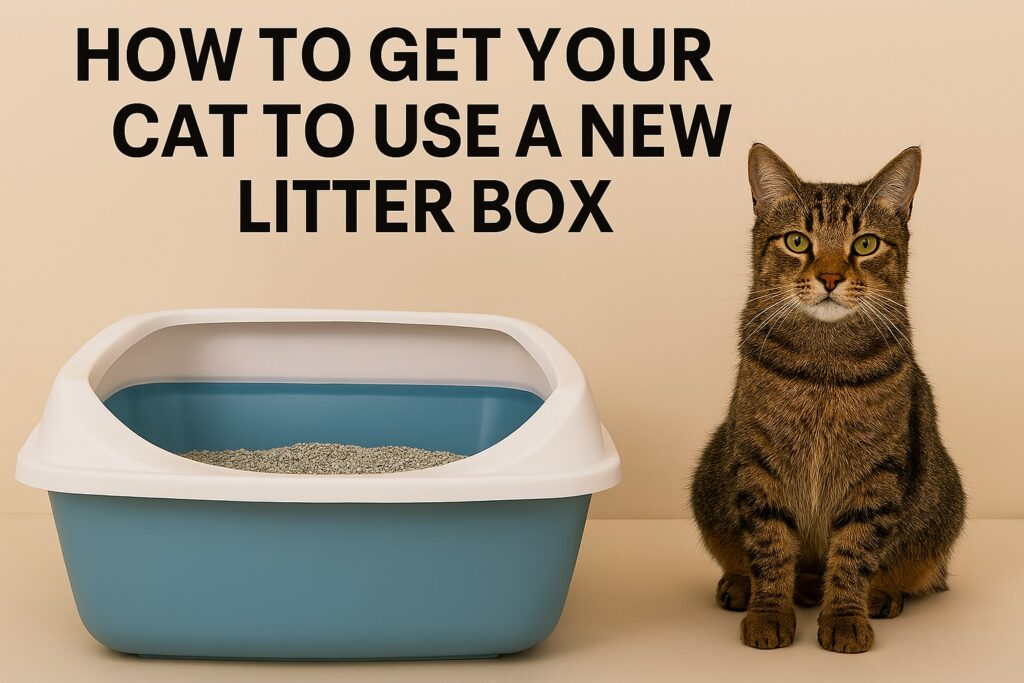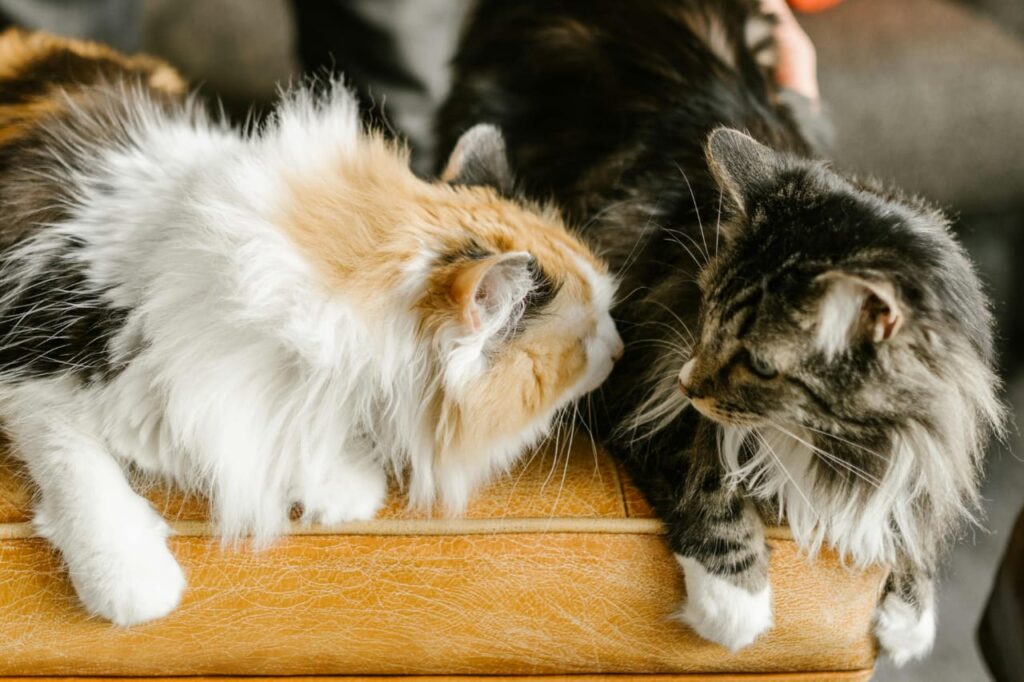
If you’ve just brought home a new litter box and your cat is giving it the cold shoulder, you’re not alone. Cats are creatures of habit, and even a small change in their bathroom setup can lead to stress, confusion, or outright refusal to use the new box. While this can be frustrating for pet parents, the good news is that most cats can successfully adjust with a little patience and the right approach.
In this guide, we’ll explore the common reasons cats avoid new litter boxes, proven steps to help them transition smoothly, and simple tricks to make the box more appealing. By the end, you’ll know exactly how to help your cat feel comfortable and confident using their new litter box.
Table of Contents
2. Step-by-step guide — How to get your cat to use a new litter box
Nice — here’s a clear, actionable plan you can follow. Read once to get the idea, then use the 2-week timeline below to run the plan day-by-day.
Quick supplies checklist
- New litter box (big enough for your cat; low entry if senior/kitten)
- The litter your cat already uses (old litter or a small container of it)
- New litter you want to switch to (if changing)
- Scooper, litter mat, unscented cleaner
- Treats or a clicker for a reward
Step 1 — Set up both boxes side-by-side (Day 0)
Place the new and old litter boxes right next to each other in the current litter location. Put some of the old litter into the new box (a thin layer or a scoop) so the smell is familiar. This removes the “newness” shock.
Why: Cats rely on scent. If the new box smells like the old one, your cat is more likely to try it.
Step 2 — Let your cat explore (Days 0–3)
Don’t force them. Encourage exploration:
- Leave the lid open (if it’s covered and your cat is wary).
- Put a treat a short distance from the new box, then another closer, then next to it.
- If your cat is curious, let them sniff and step in on their own.
Do not shove your cat into the box or scold if they avoid it.
Step 3 — Gradually change the litter (Days 1–10)
If you’re changing litter type, mix old + new slowly. Example schedule:
- Days 1–3: 75% old litter / 25% new
- Days 4–6: 50% / 50%
- Days 7–9: 25% old / 75% new
- Day 10: 100% new
Keep both boxes during this mixing phase. If your cat shows stress, slow the transition.
Step 4 — Keep the box impeccably clean (ongoing)
Scoop at least once daily. Full litter change and wash the box with unscented, mild soap every 1–2 weeks (or sooner if clumping litter requires). Avoid harsh-smelling cleaners — cats hate strong scents.
Tip: Scoop immediately after use when possible — cats prefer a freshly scooped box.
Step 5 — Move the new box gradually to its final spot (after consistent use)
Once your cat uses the new box reliably for 3–4 days, move it 1–2 feet every 2–3 days toward the desired permanent location. If you move it too fast, the cat may get confused and go elsewhere.
Step 6 — Reward and reinforce good behavior (ongoing)
When you see your cat use the new box, give a small treat or gentle praise right after (not before). Consistent positive reinforcement speeds learning.
Avoid punishing or rubbing their nose in accidents — that increases stress and makes the problem worse.
Step 7 — Phase out the old box (after consistent new-box use)
Keep both boxes until your cat uses the new box consistently for at least 7–14 days. Then remove the old box. If your cat regresses, put the old box back and slow the transition.
Common mistakes to avoid
- Swapping litter type and moving the box at the same time.
- Using strongly scented litter or cleaners.
- Removing the old box too early.
- Punishing accidents.
- Ignoring possible medical causes.
3. Why Cats Avoid New Litter Boxes
If your cat is refusing to use their new litter box, it’s not because they want to frustrate you. Cats are creatures of habit, and even small changes in their environment can feel overwhelming. Here are the most common reasons your cat may be avoiding the new setup:
Size & Type Issues
Cats need enough room to turn around and dig comfortably. If the box is too small, covered when they prefer open, or has an entry that’s too high (especially for kittens or older cats), they may reject it.
Litter Change
Switching litter brands or types can cause resistance. Cats are sensitive to texture and smell, and a sudden change from unscented to scented litter—or from fine-grain to coarse—may feel completely unfamiliar.
Placement Problems
Where you put the box matters. Cats avoid boxes placed in noisy, high-traffic, or exposed areas. They also dislike litter boxes set too close to their food and water bowls. Privacy and safety are key.
Cleanliness & Odor
Cats are fastidious creatures. A dirty or smelly box can be enough reason for them to look for other spots. Even if the box is new, it must be kept clean and free from lingering odors.
Stress or Anxiety
Environmental changes—like moving to a new home, introducing another pet, or rearranging furniture—can make cats anxious. That stress often shows up in their litter box habits.
Medical Concerns
If your cat suddenly stops using the litter box, it could be a health issue rather than the box itself. Conditions like urinary tract infections, bladder stones, or constipation can make elimination painful, leading your cat to associate the new box with discomfort. A vet check is always wise if the problem persists.
4. Tips to Make the New Litter Box More Attractive
Cats are more likely to accept a new litter box if it feels safe, comfortable, and familiar. These simple adjustments can make the transition much smoother:
Use Unscented, Soft-Texture Litter
Most cats prefer fine-grain, unscented litter because it feels soft on their paws and doesn’t overwhelm their sensitive noses. Avoid strong fragrances or rough textures that may discourage use.
Add Catnip or Litter Attractants
Sprinkling a small amount of catnip or using a litter attractant (such as Dr. Elsey’s Cat Attract) can help draw curious cats to the box. This can be especially useful during the first few days of transition.
Buy now: Best cat litter attractants
Ensure the Box Is Private Yet Accessible
Cats want privacy, but they also don’t want to feel trapped. Place the litter box in a quiet, low-traffic area that’s easy for your cat to reach. Avoid noisy appliances, drafty spots, or cramped corners.
Provide Enough Boxes for Multi-Cat Households
The golden rule is one box per cat, plus one extra. This prevents competition, territorial disputes, and stress that may cause cats to avoid the new box altogether.
Use Litter Mats to Keep the Area Clean
Cats dislike stepping into scattered litter or tracking it across the house. A good litter mat helps keep the area tidy, making the box more inviting while reducing cleanup for you.
5. Product Recommendations
The right products can make all the difference when helping your cat adjust to a new litter box. Here are some options cat parents often find helpful:
Best Litter Boxes for Picky Cats
Look for boxes that are large, open, and easy to enter. Senior cats or kittens may prefer low-entry boxes, while tech-savvy owners might benefit from self-cleaning or semi-automatic litter box models that keep things extra tidy.
Unscented Clumping Litter Options
Most cats favor fine-grain, unscented clumping litter. It’s soft on their paws, easy to scoop, and keeps odors under control without the overpowering scents many cats dislike.
Litter Attractant Products
Products like Dr. Elsey’s Cat Attract are designed to naturally draw cats to the box with herbal attractants. These can be especially helpful for stubborn cats who resist new setups.
Litter Mats & Odor Control Sprays
A durable litter mat helps contain scatter, keeping the area clean and more inviting for your cat. Unscented odor-control sprays and deodorizers can also help maintain freshness without deterring your pet.
6. Troubleshooting: What If My Cat Still Refuses?
Even with the right setup and plenty of patience, some cats may still resist using a new litter box. If that happens, try these steps before getting discouraged:
Double-Check Location, Size, and Cleanliness
Make sure the box is large enough, in a quiet and private spot, and scooped daily. Even small oversights in these areas can make the box unappealing.
Return to the Old Litter Type and Retry Slowly
If you switched litter at the same time, go back to the original brand or texture your cat is used to. Then reintroduce the new litter gradually by mixing small amounts over several days.
Rule Out Medical Issues
Persistent refusal may signal a health problem like a urinary tract infection, bladder stones, or constipation. If your cat is straining, vocalizing in pain, or urinating outside the box frequently, a vet visit is essential.
Consider Stress Triggers in the Environment
New pets, moving homes, loud noises, or even rearranging furniture can create stress that disrupts litter box habits. Try to identify and minimize these stressors, and give your cat extra reassurance and quiet time.
7. Conclusion
Introducing a new litter box doesn’t have to be stressful. By understanding why cats resist change, setting up the box correctly, and making adjustments step by step, you can help your cat feel comfortable and confident.
Remember: patience is your greatest tool. Every cat is different—what works in a few days for one may take a couple of weeks for another. Stay consistent, avoid punishment, and reward progress. With time and the right approach, most cats happily accept their new litter box and return to healthy, stress-free bathroom habits.
8. FAQs
How long does it take for a cat to use a new litter box?
Most cats adjust within 1–2 weeks, but picky or anxious cats may take longer. Patience and consistency are key.
Should I remove the old litter box right away?
No. Keep both boxes side by side during the transition. Remove the old one only after your cat consistently uses the new box for at least 7–14 days.
Can I train an older cat to use a new litter box?
Yes. Older cats may take longer to adapt, but gradual changes and low-entry boxes make the process easier.
Is it better to change litter type gradually or all at once?
Gradual is best. Mix the old and new litter slowly over 7–10 days to avoid resistance.
What if my cat still refuses after weeks?
Double-check box size, placement, and cleanliness. If everything is correct and your cat still refuses, consult a vet to rule out medical issues.








